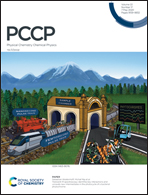The structural α-relaxation times of prilocaine confined in 1 nm pores of molecular sieves: quantitative explanation by the coupling model
Abstract
The molecular glass-former and pharmaceutical, prilocaine, distinguishes itself by exhibiting seven general and fundamental dynamic and thermodynamic properties [Z. Wojnarowska, et al., J. Phys. Chem. B, 2015, 39, 12699.], all of which have been explained using the coupling model. What has not been studied before are the changes in properties of the structural α-relaxation of prilocaine when subjected to extreme nano-confinement in spaces with a size of about 1 nm. Recently, Ruis et al. [G. N. Ruiz, et al., Phys. Chem. Chem. Phys., 2019, 21, 15576.] measured the α-relaxation times, τα,conf(T), of prilocaine confined in 1 nm pores of molecular sieves. They found that τα,conf(T) are significantly reduced from those of bulk prilocaine, τα,bulk(T), and assume a weaker temperature dependence. The data in toto pose a challenge for any theory of glass transition to explain quantitatively. The coupling model (CM) was applied to this problem to predict the α-relaxation times of prilocaine when cooperativity is removed, which is expected because only a few prilocaine molecules can fit into the 1 nm pores. The results from the CM are in quantitative agreement with the experimental values of τα,conf(T) and the temperature dependence. The success is nontrivial because no other extant theory can do the same to the best of our knowledge.

- This article is part of the themed collection: 2020 PCCP HOT Articles


 Please wait while we load your content...
Please wait while we load your content...